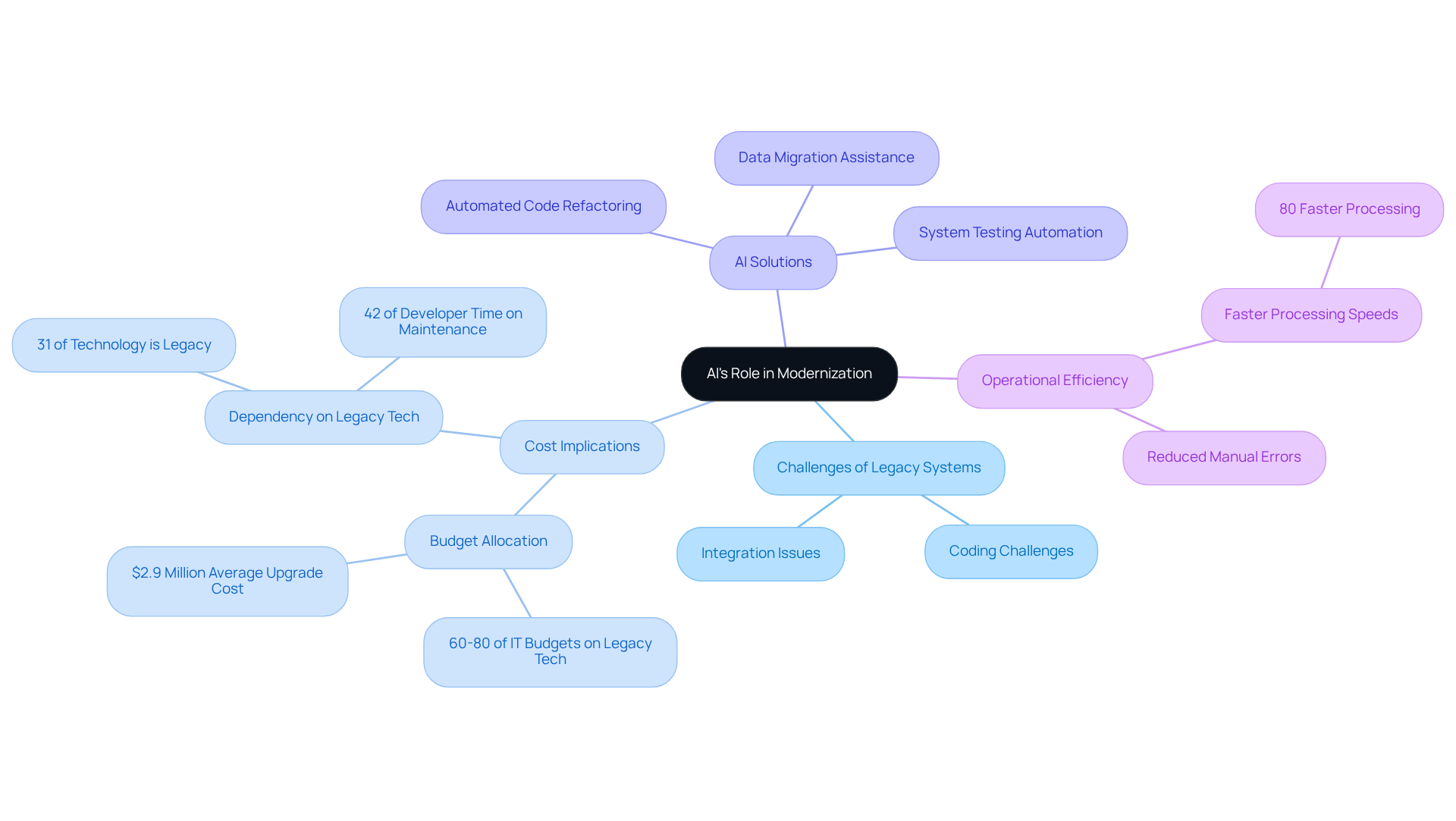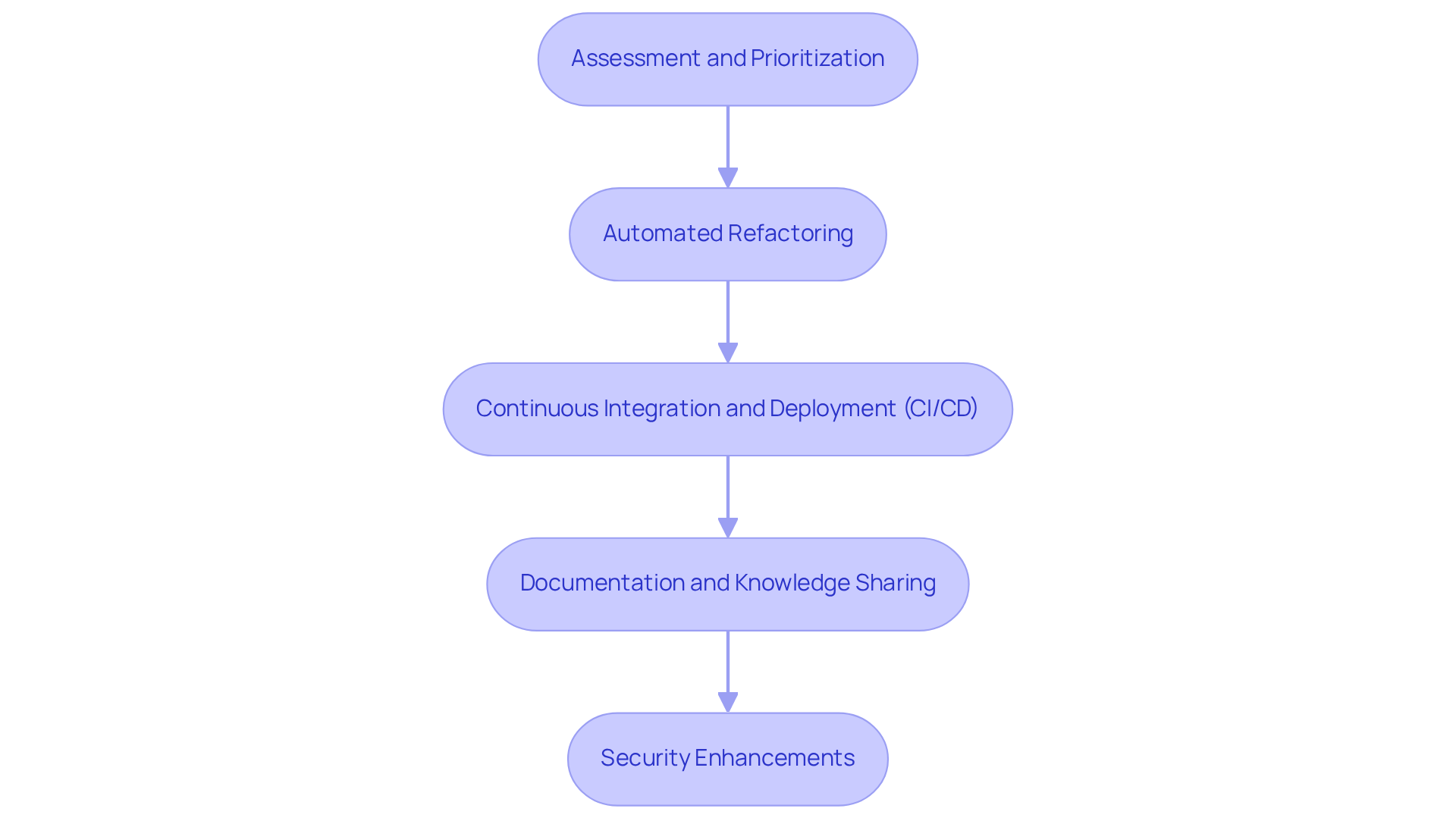Overview
Organizations today face significant challenges with legacy code, which can hinder their ability to innovate and adapt. How can they overcome these hurdles? By leveraging AI-driven strategies, companies can modernize their codebases effectively. Automation of processes such as code refactoring and system testing not only enhances operational efficiency but also reduces costs. Furthermore, it addresses the pressing issues posed by outdated technologies, paving the way for a seamless transition to modern architectures.
Imagine a scenario where your team can focus on developing new features instead of wrestling with old code. Kodezi offers a solution by automating tedious coding tasks, allowing developers to reclaim valuable time. With features designed to streamline workflows, Kodezi empowers teams to tackle legacy code with confidence.
The benefits of using Kodezi are clear:
- Improved productivity
- Enhanced code quality
- A more agile development process
In addition, these tools provide developers with the support they need to navigate the complexities of modernization. Why not explore how Kodezi can transform your coding practices?
By adopting Kodezi, organizations can not only modernize their legacy systems but also foster a culture of innovation. The time to act is now—discover the tools available on the platform and take the first step toward a more efficient coding future.
Introduction
Legacy systems often serve as the backbone of many organizations, yet they can also present significant roadblocks to innovation and efficiency. As businesses increasingly turn to AI for modernization, the potential benefits of updating these outdated technologies are immense, ranging from cost savings to enhanced operational capabilities. However, the journey to successful AI code modernization is fraught with challenges.
How can organizations effectively navigate the complexities of legacy systems while leveraging AI to streamline their processes? This is where Kodezi comes in, providing solutions that address these challenges head-on.
Understand Legacy Systems and AI's Role in Modernization
Legacy technologies present significant coding challenges for developers, often hindering operational efficiency. These outdated software applications and infrastructures, while essential for daily operations, struggle to integrate with modern technologies. Have you ever wondered how much these inefficiencies are costing your organization? AI code modernization can play a pivotal role in addressing these challenges by automating critical processes such as code refactoring, data migration, and system testing.
Imagine enhancing your operational efficiency while reducing costs and minimizing manual errors. By leveraging AI, companies can facilitate a smoother transition to contemporary architectures. The CLI exemplifies this transformation by autonomously enhancing codebases, promptly detecting and rectifying codebase issues, and offering comprehensive explanations of what went wrong. Furthermore, addressing specific challenges posed by legacy systems—such as compatibility issues and high maintenance costs—is crucial for successful modernization efforts.
Consider this: almost one-third of entities reported that up to 25% of their legacy infrastructures are incapable of supporting AI tools and workloads. This statistic highlights the increasing dependence on AI-powered solutions to tackle these pressing challenges. Moreover, companies allocate between 60-80% of their IT budgets to supporting legacy technologies, emphasizing the financial consequences of these obsolete solutions.
The AI-driven programming tool not only autonomously rectifies code and examines errors but also integrates effortlessly with GitHub and CI/CD workflows. This offers a thorough strategy for AI code modernization of outdated infrastructures. Adopting this tool can significantly improve your entity's capacity to upgrade legacy systems efficiently. Why not explore the tools available on the platform and see how they can revolutionize your coding practices?

Implement Proven Strategies for AI-Driven Code Modernization
To successfully achieve AI code modernization, organizations face significant coding challenges that can hinder progress. How can these challenges be effectively addressed? Kodezi offers a range of strategies designed to streamline this process.
-
Assessment and Prioritization: Begin by assessing the current state of your codebase. Identify components that are outdated or problematic and prioritize them for modernization.
-
Automated Refactoring: Utilize AI tools that can independently enhance your software repository, resolving errors and improving quality before they reach production. This automation streamlines the refactoring process, making it simpler to update legacy systems without introducing new bugs.
-
Continuous Integration and Deployment (CI/CD): Implement CI/CD pipelines to facilitate ongoing updates and testing, ensuring that new changes do not disrupt existing functionality. The CLI enhances this process by offering swift issue resolution and performance optimization.
-
Documentation and Knowledge Sharing: Utilize AI to automatically refresh documentation as programming alterations take place, ensuring that all team members have access to the most current information. This synchronization is crucial for maintaining clarity and consistency across the development team.
-
Security Enhancements: Use AI tools to identify and remediate security vulnerabilities within the codebase, ensuring compliance with industry standards. Kodezi CLI enforces security best practices and programming standards, further enhancing quality and automated testing.
By following these strategies, entities can effectively achieve AI code modernization in their codebases while minimizing risks and maximizing efficiency. Are you ready to explore the tools available on the Kodezi platform to enhance your coding practices?

Ensure Continuous Maintenance and Monitoring for Long-Term Success
In the fast-evolving world of software development, coding challenges are a constant hurdle for developers. To ensure the long-term success of AI code modernization, organizations must adopt a proactive maintenance and monitoring strategy. This involves several key practices that not only address common pain points but also enhance overall productivity.
- Regular Review Sessions are essential for early identification of potential issues. Conducting periodic review sessions ensures compliance with programming standards. Research indicates that thorough software reviews correlate with lower defect rates, making this practice a cornerstone of quality assurance.
- Furthermore, deploying Automated Monitoring Tools is crucial for tracking program performance and identifying anomalies in real-time. Solutions like the Kodezi CLI autonomously improve codebases and fix bugs before they reach production. This enhances reliability and security by providing immediate insights into system health, allowing teams to address issues swiftly before they escalate.
- In addition, establishing Feedback Loops with development teams fosters continuous improvement. By consistently collecting insights on software performance and areas requiring enhancement, organizations can adjust their strategies to effectively tackle changing challenges.
- Investing in Training and Development for developers is vital. Ongoing education ensures that teams remain informed about the latest technologies and best practices in software maintenance. This knowledge empowers teams to leverage advanced monitoring techniques, such as anomaly detection and predictive analytics, optimizing their workflows.
- Lastly, adopting Iterative Improvements allows for continuous enhancements based on performance metrics and user feedback. This strategy not only improves code quality but also aligns development efforts with business objectives. The CLI supports multiple languages and IDEs, making it a versatile tool for teams.
By prioritizing continuous maintenance and monitoring, organizations can achieve AI code modernization to ensure efficient, secure codebases that support their long-term goals. The expected impact of these practices includes enhanced reliability, reduced technical debt, and improved alignment with business objectives. Explore Kodezi's AI-powered programming tools to significantly bolster these efforts and elevate your coding practices.

Conclusion
AI code modernization is crucial for organizations aiming to enhance operational efficiency and cut costs linked to legacy systems. Are you facing challenges with outdated software? By leveraging advanced AI tools, businesses can automate critical processes, streamline coding practices, and ensure a smoother transition to modern architectures. This modernization not only tackles the technical difficulties posed by obsolete systems but also positions organizations to excel in an increasingly competitive landscape.
Key strategies for successful AI-driven code modernization include:
- A thorough assessment and prioritization of legacy components
- Automated refactoring
- The implementation of continuous integration and deployment practices
Furthermore, fostering a culture of documentation, knowledge sharing, and ongoing training for developers is vital for maintaining high-quality codebases. By adopting these practices, organizations can effectively navigate the complexities of modernization while minimizing risks and maximizing efficiency.
Ultimately, the journey toward AI code modernization transcends mere technology upgrades; it represents a fundamental shift in how organizations approach software development. Embracing continuous maintenance and monitoring will ensure that codebases remain reliable and aligned with business objectives. As companies explore the tools and strategies available, they position themselves for long-term success in an era where agility and innovation are paramount. Are you ready to embrace the future of coding and transform your legacy systems with AI-driven solutions today?
Frequently Asked Questions
What are legacy systems and why are they a challenge for developers?
Legacy systems are outdated software applications and infrastructures that present significant coding challenges for developers, often hindering operational efficiency and struggling to integrate with modern technologies.
How does AI contribute to the modernization of legacy systems?
AI contributes to modernization by automating critical processes such as code refactoring, data migration, and system testing, which enhances operational efficiency while reducing costs and minimizing manual errors.
What specific issues do legacy systems present that AI can help address?
AI can help address issues such as compatibility problems, high maintenance costs, and the inability of many legacy infrastructures to support AI tools and workloads.
What is the impact of legacy systems on IT budgets?
Companies allocate between 60-80% of their IT budgets to supporting legacy technologies, highlighting the financial consequences of maintaining these obsolete solutions.
How does the AI-driven programming tool improve the modernization process?
The AI-driven programming tool autonomously rectifies code, examines errors, and integrates seamlessly with GitHub and CI/CD workflows, providing a comprehensive strategy for upgrading legacy systems efficiently.
What percentage of organizations report that their legacy infrastructures cannot support AI tools?
Almost one-third of entities reported that up to 25% of their legacy infrastructures are incapable of supporting AI tools and workloads.
What advantages does leveraging AI for code modernization offer organizations?
Leveraging AI for code modernization offers advantages such as enhanced operational efficiency, reduced costs, minimized manual errors, and a smoother transition to contemporary architectures.




